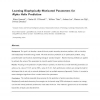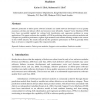85 search results - page 2 / 17 » Active machine learning for transmembrane helix prediction |
BMCBI
2007
13 years 8 months ago
2007
Background: Our goal is to develop a state-of-the-art protein secondary structure predictor, with an intuitive and biophysically-motivated energy model. We treat structure predict...
CSB
2005
IEEE
14 years 2 months ago
2005
IEEE
The explanation of a decision is important for the acceptance of machine learning technology in bioinformatics applications such as protein structure prediction. In past research,...
BMCBI
2006
13 years 8 months ago
2006
Background: The structure of proteins may change as a result of the inherent flexibility of some protein regions. We develop and explore probabilistic machine learning methods for...
JSS
2008
13 years 8 months ago
2008
Effective prediction of defectprone software modules can enable software developers to focus quality assurance activities and allocate effort and resources more efficiently. Supp...
ICCS
2007
Springer
14 years 2 months ago
2007
Springer
In this paper, active learning with support vector machines (SVMs) is applied to the problem of tornado prediction. This method is used to predict which storm-scale circulations yi...


